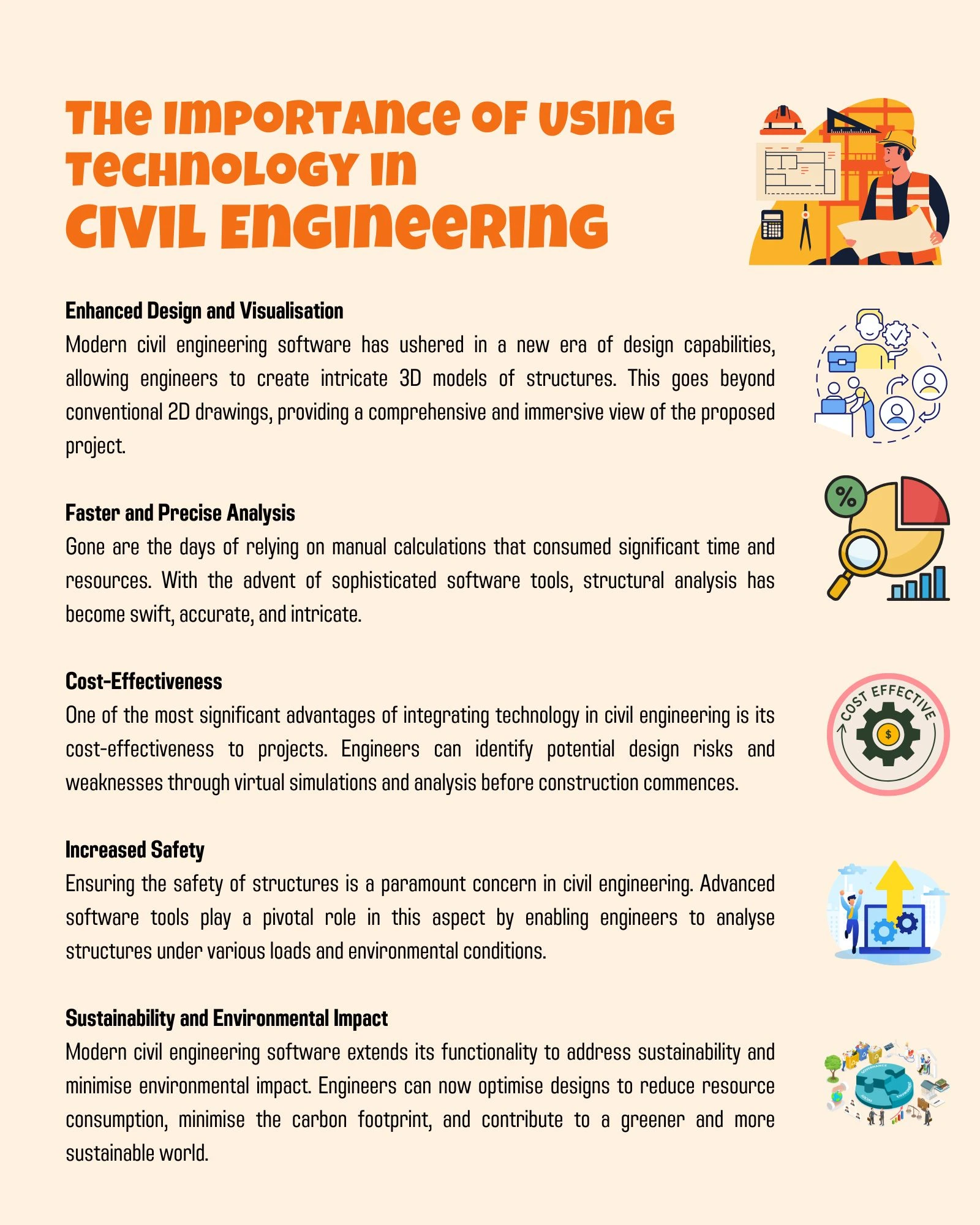- Table of Contents
- Introduction
- The Importance of Using Technology in Civil Engineering
- Enhanced Design and Visualisation
- Faster and Precise Analysis
- Cost-Effectiveness
- Increased Safety
- Sustainability and Environmental Impact
- The Evolution of Structural Analysis Software
- Pre-Digital Era
- Emergence of Digital Computers
- Finite Element Method (FEM): A Significant Milestone
- Integration of FEM in Structural Analysis Software
- User-Friendly Interfaces and Advanced Features
- Interdisciplinary Integration
- Current State
- Future Prospects
- Top 10 Structural Analysis Software
- 1. SAP2000
- 2. ETABS
- 3. STAAD.Pro
- 4. ANSYS
- 5. RISA-3D
- 6. RAM Structural System
- 7. MIDAS Civil
- 8. LUSAS Civil & Structural
- 9. SCIA Engineer
- 10. Robot Structural Analysis Professional
- Innovations and Trends in Structural Analysis Software
- Artificial Intelligence in Structural Analysis
- Cloud-Based Structural Analysis
- Augmented Reality (AR) for Structural Visualisation
- Challenges and Future Outlook
- Conclusion
Introduction
Civil engineering has played an essential role in shaping the modern world, with its structures ranging from towering skyscrapers to intricate bridges. Over the years, technological advancements have revolutionised the field, allowing engineers to leverage sophisticated software tools that streamline the design, analysis, and construction processes. This blog post will delve into the importance of using technology in civil engineering, particularly focusing on structural analysis software. By the end, we'll also explore the top 10 structural analysis software programmes leading the way in the industry.
The Importance of Using Technology in Civil Engineering
Technology has become an integral part of modern civil engineering practices, bringing efficiency, accuracy, and safety to the forefront of every project. Embracing technology improves project delivery times and ensures cost-effectiveness and sustainability. Here are some key points highlighting the importance of using technology in civil engineering:

Enhanced Design and Visualisation
Modern civil engineering software has ushered in a new era of design capabilities, allowing engineers to create intricate 3D models of structures. This goes beyond conventional 2D drawings, providing a comprehensive and immersive view of the proposed project. The enhanced visualisation facilitates a deeper understanding of the design's intricacies, enabling engineers to identify potential issues in the early stages of the project.
Identifying and addressing design flaws before breaking ground is a monumental advantage. Engineers can navigate through the virtual model, exploring different angles and perspectives, ensuring that every aspect of the structure is thoroughly examined. This contributes to better decision-making and minimises the likelihood of costly modifications during the construction phase.
Faster and Precise Analysis
Gone are the days of relying on manual calculations that consumed significant time and resources. With the advent of sophisticated software tools, structural analysis has become swift, accurate, and intricate. Engineers can now simulate various structural scenarios efficiently, exploring design alternatives and selecting the most optimal solution.
The speed of analysis is particularly crucial in the fast-paced world of construction, where project timelines are often tight. The precision afforded by these tools ensures that the design's structural integrity is rigorously assessed. This, in turn, enables engineers to make informed decisions about the viability and safety of the proposed structures.
Cost-Effectiveness
One of the most significant advantages of integrating technology in civil engineering is its cost-effectiveness to projects. Engineers can identify potential design risks and weaknesses through virtual simulations and analysis before construction commences. This proactive approach minimises the need for costly rework, ultimately saving both time and money.
Engineers can optimise designs by simulating different scenarios virtually, ensuring that the chosen solution is structurally sound and economically viable. This proactive, cost-effective approach contributes to more efficient project delivery and a streamlined construction process.
Increased Safety
Ensuring the safety of structures is a paramount concern in civil engineering. Advanced software tools play a pivotal role in this aspect by enabling engineers to analyse structures under various loads and environmental conditions. This thorough analysis helps detect potential vulnerabilities in the design, allowing engineers to make necessary modifications to enhance safety and resilience.
The capability to simulate and evaluate the structural response under different conditions ensures that safety considerations are embedded in the design phase itself. This proactive approach significantly reduces the risk of structural failures during construction or throughout the structure's lifespan, safeguarding both human lives and investments.
Sustainability and Environmental Impact
Modern civil engineering software extends its functionality to address sustainability and minimise environmental impact. Engineers can now optimise designs to reduce resource consumption, minimise the carbon footprint, and contribute to a greener and more sustainable world.
Integrating sustainability considerations into the design process reflects a broader commitment to environmentally conscious practices. Engineers can explore eco-friendly materials, energy-efficient designs, and construction methods that align with global efforts to create a more sustainable built environment. This aligns civil engineering projects with broader environmental goals, making them structures and contributors to a sustainable future.
Software | Sustainability Features | Environmental Impact Foocus |
RISA-£D | Eco-friendly materials minimal environmental impact | Reduces resource consumption and carbon footprint |
MIDAS Civil | Comprehensive sustainability range, resource efficiency | Minimises environmental impact through optimised designs |
LUSAS Civil | Advanced finite element analysis for sustainable design | Promotes eco-friendly materials and sustainable practices |
Table 1: Sustainability considerations in structural analysis software
In short, integrating technology in civil engineering, especially through advanced structural analysis software, is a game-changer. It enhances the design and visualisation process, expedites analysis, ensures cost-effectiveness, increases safety, and contributes to sustainability. As the industry evolves, embracing technology will remain imperative for engineers to overcome challenges and build a better, more resilient world for future generations.
The Evolution of Structural Analysis Software
The evolution of structural analysis software represents a remarkable journey from manual calculations to sophisticated digital tools, revolutionising the way civil engineers approach design and construction. Let’s now delve into the historical background and pivotal milestones in developing structural analysis software.
Pre-Digital Era
Before the advent of digital computers in the mid-20th century, civil engineers relied on laborious manual calculations and simplified assumptions to analyse structures. These manual methods had inherent limitations, restricting the complexity and accuracy of designs. Engineers grappled with time-consuming processes, and the available computational power constrained the ability to analyse intricate structures.
Emergence of Digital Computers
The introduction of digital computers marked a turning point in the field of structural analysis. In the mid-20th century, engineers began harnessing the computational power of these machines to perform numerical analyses. This shift from manual calculations to numerical methods paved the way for more sophisticated and accurate structural analyses.
Finite Element Method (FEM): A Significant Milestone
Among the early numerical methods, the Finite Element Method (FEM) emerged as a significant milestone in the development of structural analysis software. FEM allowed engineers to divide complex structures into smaller, manageable elements, facilitating a more detailed and accurate analysis. This method laid the foundation for modern structural analysis software by providing a systematic approach to model and simulate the behaviour of structures under various conditions.
Integration of FEM in Structural Analysis Software
As digital technology advanced, the Finite Element Method became a cornerstone of structural analysis software. This integration enabled engineers to model structures with unprecedented precision, considering factors such as material properties, loads, and environmental conditions. Structural analysis software evolved into comprehensive tools capable of simulating real-world scenarios and predicting the behaviour of structures with a high degree of accuracy.
User-Friendly Interfaces and Advanced Features
With the progression of technology, structural analysis software has become more powerful and user-friendly. Intuitive interfaces allowed engineers to interact with the software seamlessly, facilitating the creation and manipulation of complex models. Advanced features, such as 3D modelling and simulation capabilities, further enhanced the software's utility, enabling engineers to visualise and analyse structures in unprecedented detail.
Interdisciplinary Integration
In addition to advancing structural analysis capabilities, modern software transcends disciplinary boundaries. Many contemporary structural analysis tools are part of comprehensive suites that integrate with other engineering disciplines, such as architecture and construction management. This interdisciplinary integration streamlines the design and construction process, fostering stakeholder collaboration.
Current State
Today, the landscape of structural analysis software is diverse, offering many options catering to various engineering needs. Specialised tools have emerged, focusing on specific aspects such as seismic analysis, dynamic simulations, and material optimisation. Engineers can choose from a range of software solutions based on the requirements of their projects, whether they involve high-rise buildings, bridges, or other infrastructure.
Future Prospects
Looking ahead, the future of structural analysis software holds exciting possibilities. Advancements in simulation technologies, including real-time simulations and virtual reality integration, are on the horizon. These innovations will give engineers even more immersive experiences, enabling them to assess and refine designs in dynamic, interactive environments.
Furthermore, collaboration is expected to play a central role in the evolution of structural analysis software. Enhanced interoperability between different software platforms and disciplines will foster seamless collaboration among architects, engineers, and construction professionals. This collaborative approach will streamline the design process and contribute to more holistic and integrated solutions.
In summary, the evolution of structural analysis software mirrors the broader technological advancements in the field of civil engineering. From manual calculations to sophisticated digital tools, the journey has been transformative. As software continues to evolve, it empowers engineers to push the boundaries of design and construction, laying the foundation for creating safer, more sustainable, and innovative structures. The ongoing evolution of structural analysis software is a testament to the dynamic nature of the civil engineering field, where technology continues to shape how we build the world around us.
Top 10 Structural Analysis Software
Structural analysis software is dynamic, with cutting-edge tools continuously pushing the boundaries of what civil engineers can achieve. Let’s delve into the top 10 structural analysis software programs currently leading the industry, each offering unique features and capabilities.
1. SAP2000
Developed by Computers and Structures, Inc. (CSI), SAP2000 is a widely used and trusted structural analysis and design software. Its intuitive interface, powerful analysis capabilities, and comprehensive design features make it a worldwide go-to choice for civil engineers. SAP2000 excels in handling simple and complex structures, providing a versatile solution for various engineering projects.
2. ETABS
Also crafted by CSI, the ETABS (Extended Three-Dimensional Analysis of Building Systems) software specialises in the analysis and design of building structures. Renowned for its prowess in handling complex structural models, ETABS excels in seismic analysis and dynamic simulations. Its user-friendly interface and advanced analytical features position it as a preferred choice for engineers working on high-rise buildings and intricate architectural designs.
3. STAAD.Pro
Developed by Bentley Systems, STAAD.Pro is another heavyweight in the structural analysis and design software arena. Known for its versatility, STAAD.Pro supports various materials and design codes, making it suitable for various engineering projects. Its advanced analytical tools and efficient workflows empower engineers to tackle projects of varying complexities, from small-scale structures to large infrastructure developments.
Software | Description | Notable Features |
SAP2000 | CSI's intuitive design with powerful analysis capabilities. | Versatile for various engineering projects. |
ETABS | Specialised in seismic analysis and dynamic simulations. | Efficient workflow for high-rise buildings. |
STAAD.Pro | Versatile software supporting various materials and codes. | Streamlines design for small to large-scale projects. |
ANSYS | Comprehensive suite for advanced structural analysis. | Widely applicable across diverse industries. |
RISA-3D | User-friendly software excelling in 3D modelling. | Detailed analysis of various building components. |
Table 2: Comparison of the top 5 structural analysis software programmes
4. ANSYS
ANSYS is a comprehensive suite of engineering simulation software that includes ANSYS Structural, which focuses on advanced structural analysis and multi-physics simulations. Widely utilised across various industries beyond civil engineering, ANSYS offers robust capabilities for engineers exploring intricate structural behaviours and simulating real-world conditions. Its broad applicability makes it a valuable asset for engineers involved in diverse projects.
5. RISA-3D
Developed by RISA Technologies, RISA-3D is a user-friendly structural analysis and design software that particularly excels in 3D modelling and simulation. Known for its detailed analysis of various building components, RISA-3D provides engineers with a comprehensive toolset for designing structurally sound and resilient structures. Its emphasis on ease of use makes it an attractive choice for engineers seeking efficiency in their design workflows.
6. RAM Structural System
Also developed by Bentley Systems, the RAM Structural System is a powerful software suite dedicated to analysing and designing concrete and steel structures. Its user-friendly interface and seamless integration capabilities make it a top choice for engineers involved in designing diverse structural systems. RAM Structural System streamlines the design process, ensuring efficiency and accuracy in creating safe and resilient structures.
7. MIDAS Civil
MIDAS Civil offers a comprehensive range of civil engineering solutions, encompassing structural analysis, design, and construction management. Tailored for complex infrastructure projects such as bridges and highways, MIDAS Civil boasts advanced features catering to large-scale developments' intricate demands. Its holistic approach to civil engineering makes it a valuable tool for engineers engaged in multifaceted projects.
8. LUSAS Civil & Structural
Renowned for its advanced finite element analysis capabilities and comprehensive design tools, LUSAS Civil & Structural is a software solution often employed to analyse bridges, tunnels, and other large-scale structures. Its ability to handle complex geometries and materials makes it a preferred choice for engineers seeking a robust platform for tackling intricate structural challenges.
9. SCIA Engineer
Developed by SCIA, SCIA Engineer is a versatile software package catering to the analysis and design of various structural materials, including concrete, steel, and timber. With parametric modelling capabilities that streamline the design process, SCIA Engineer offers engineers flexibility and efficiency in addressing diverse structural requirements. Its adaptability makes it suitable for a wide spectrum of engineering projects.
10. Robot Structural Analysis Professional
Autodesk's Robot Structural Analysis Professional is a Building Information Modeling (BIM)-integrated software designed for structural analysis and simulation. Its interoperability with other Autodesk products positions it as a preferred choice in the construction industry, where seamless collaboration between different disciplines is crucial. The software's integration with BIM enhances the overall efficiency and accuracy of the design and construction processes.
Innovations and Trends in Structural Analysis Software
Artificial Intelligence in Structural Analysis
Integrating artificial intelligence (AI) in structural analysis software is a notable trend as technology advances. AI algorithms can analyse vast datasets to identify patterns and optimise structural designs, contributing to more efficient and resource-conscious engineering solutions.
Cloud-Based Structural Analysis
The shift towards cloud-based solutions in structural analysis software is gaining momentum. This allows for seamless collaboration among project stakeholders, real-time updates, and accessibility from various locations. Cloud-based platforms enhance flexibility and scalability, particularly in large-scale projects with geographically dispersed teams.
Augmented Reality (AR) for Structural Visualisation
Augmented reality is making its mark in the realm of structural analysis. By overlaying digital information onto the physical environment, engineers can visualise and interact with structural models in real-world settings. This technology enhances on-site decision-making, improving efficiency and reducing errors during construction.
Challenges and Future Outlook
Interoperability Challenges
While structural analysis software has made tremendous strides, interoperability challenges persist. The seamless data exchange between different software platforms remains a hurdle that the industry must address. Efforts to standardise data formats and improve compatibility are ongoing to enhance collaboration and efficiency.
Integration of Sustainable Design Practices
The future of structural analysis software will likely see an increased focus on integrating sustainable design practices. This involves optimising structures for minimal environmental impact and incorporating materials and construction methods that align with eco-friendly principles.
Advancements in Materials Science
Structural analysis software must adapt as materials science advances to accommodate innovative materials. This includes analysing structures built with new materials that offer enhanced strength, durability, and sustainability.
Conclusion
Civil engineering software has become a cornerstone of modern infrastructure development. By embracing technology and utilising advanced structural analysis software, engineers can create safer, more sustainable, and efficient structures. These software tools enhance design and visualisation and expedite the analysis process, ultimately resulting in optimised, cost-effective projects.
As the industry continues to evolve, new innovations in civil engineering software will undoubtedly drive the development of increasingly complex and innovative structures. Embracing technology will remain crucial for engineers to tackle the challenges of tomorrow and build a better, more resilient world for generations to come.
Finally, as the field of civil engineering advances, the demand for specialised knowledge in areas like offshore structural engineering becomes increasingly crucial. Our course, ‘Offshore Structure Design, Construction, and Maintenance,’ offers a unique opportunity to dive deep into this specialised domain. Picture yourself mastering the intricacies of general and steel jackets, gaining insights into the broader view of the ocean, and acquiring skills in designing various fixed offshore platform structures. Our course doesn't just stop at design; it covers the latest techniques for analysis and maintenance, including pushover structure analysis and underwater risk-based inspection methodologies. As the industry moves towards more complex offshore structures, this course ensures you stay ahead, equipped with the expertise needed to contribute to the development of safer, more resilient offshore platforms. Don't miss the chance to be at the forefront of this exciting field – enrol now and be part of shaping the future of offshore structural engineering.






















